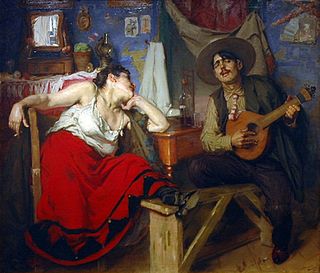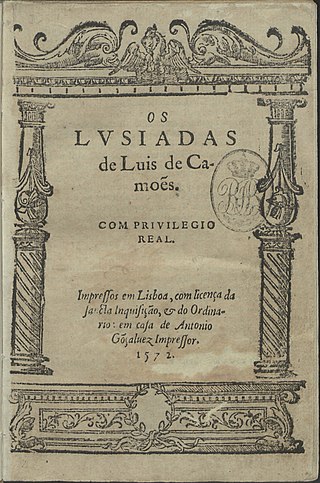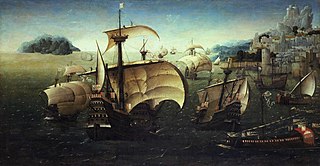
Bartolomeu Dias was a Portuguese mariner and explorer. In 1488, he became the first European navigator to round the southern tip of Africa and to demonstrate that the most effective southward route for ships lies in the open ocean, well to the west of the African coast. His discoveries effectively established the sea route between Europe and Asia.

Portuguese colonization of the Americas constituted territories in the Americas belonging to the Kingdom of Portugal. Portugal was the leading country in the European exploration of the world in the 15th century. The Treaty of Tordesillas in 1494 divided the Earth outside Europe into Castilian and Portuguese global territorial hemispheres for exclusive conquest and colonization. Portugal colonized parts of South America, but also made some unsuccessful attempts to colonize North America.

Fado is a music genre which can be traced to the 1820s in Lisbon, Portugal, but probably has much earlier origins. Fado historian and scholar Rui Vieira Nery states that "the only reliable information on the history of fado was orally transmitted and goes back to the 1820s and 1830s at best. But even that information was frequently modified within the generational transmission process that made it reach us today."

Maranhão is a state in Brazil. Located in the country's Northeast Region, it has a population of about 7 million and an area of 332,000 km2 (128,000 sq mi). Clockwise from north, it borders on the Atlantic Ocean for 2,243 km and the states of Piauí, Tocantins and Pará. The people of Maranhão have a distinctive accent within the common Northeastern Brazilian dialect. Maranhão is described in literary works such as Exile Song by Gonçalves Dias and Casa de Pensão by Aluísio Azevedo.

Os Lusíadas, usually translated as The Lusiads, is a Portuguese epic poem written by Luís Vaz de Camões and first published in 1572. It is widely regarded as the most important work of Portuguese-language literature and is frequently compared to Virgil's Aeneid. The work celebrates the discovery of a sea route to India by the Portuguese explorer Vasco da Gama (1469–1524). The ten cantos of the poem are in ottava rima and total 1,102 stanzas.

A carrack is a three- or four-masted ocean-going sailing ship that was developed in the 14th to 15th centuries in Europe, most notably in Portugal and Spain. Evolving from the single-masted cog, the carrack was first used for European trade from the Mediterranean to the Baltic and quickly found use with the newly found wealth of the trade between Europe and Africa and then the trans-Atlantic trade with the Americas. In their most advanced forms, they were used by the Portuguese for trade between Europe and Asia starting in the late 15th century, before being gradually superseded in the late 16th and early 17th centuries by the galleon.

Pedro Teixeira, occasionally referred to as the Conqueror of the Amazon, was a Portuguese explorer and military officer, who became, in 1637, the first European to travel up and down the entire length of the Amazon River, he also headed the government of the captaincy of Pará in two different periods, one in 1620-1621 and another in 1640–1641.

The Nheengatu or Nenhengatu language, or Nenhengatu, also known as Modern Tupi and Amazonic Tupi, is a Tupi–Guarani language.
Aḥmad ibn Mājid, also known as the "Arab Admiral" and the "Lion of the Sea", was an Arab navigator and cartographer born c. 1432 in Julfar, the present-day Ras Al Khaimah in the United Arab Emirates. He was raised in a family famous for seafaring; at the age of seventeen he was able to navigate ships. The exact date is not known, but Ibn Mājid probably died around 1500. Although long identified in the West as the navigator who helped Vasco da Gama find his way from Africa to India, contemporary research has shown Ibn Mājid is unlikely even to have met Da Gama. Ibn Mājid was the author of nearly forty works of poetry and prose.

Dom João de Castro was a Portuguese nobleman, scientist, writer, and the fourth viceroy of Portuguese India. He was called Castro Forte by the poet Luís de Camões. De Castro was the second son of Álvaro de Castro, the civil governor of Lisbon. His wife was Leonor de Coutinho.

The history of navigation, or the history of seafaring, is the art of directing vessels upon the open sea through the establishment of its position and course by means of traditional practice, geometry, astronomy, or special instruments. Many peoples have excelled as seafarers, prominent among them the Austronesians, the Harappans, the Phoenicians, the Iranians, the ancient Greeks, the Romans, the Arabs, the ancient Indians, the Norse, the Chinese, the Venetians, the Genoese, the Hanseatic Germans, the Portuguese, the Spanish, the English, the French, the Dutch, and the Danes.

Portuguese maritime exploration resulted in the numerous territories and maritime routes recorded by the Portuguese as a result of their intensive maritime journeys during the 15th and 16th centuries. Portuguese sailors were at the vanguard of European exploration, chronicling and mapping the coasts of Africa and Asia, then known as the East Indies, and Canada and Brazil, in what came to be known as the Age of Discovery.

The Portuguese Indian Armadas were the fleets of ships funded by the Crown of Portugal, and dispatched on an annual basis from Portugal to India. The principal destination was Goa, and previously Cochin. These armadas undertook the Carreira da Índia from Portugal, following the maritime discovery of the Cape route, to the Indian subcontinent by Vasco da Gama in 1497–99.
António de Mariz Carneiro was a Portuguese nobleman who served as the official cosmographer to the Portuguese crown.
A rutter is a mariner's handbook of written sailing directions. Before the advent of nautical charts, rutters were the primary store of geographic information for maritime navigation.

Gonçalo Álvares was a Portuguese explorer who actively participated in the Age of Discovery, starting from the second voyage of Diogo Cão.

The Portuguese discovery of the sea route to India was the first recorded trip directly from Europe to the Indian subcontinent, via the Cape of Good Hope. Under the command of Portuguese explorer Vasco da Gama, it was undertaken during the reign of King Manuel I in 1495–1499. Considered one of the most remarkable voyages of the Age of Discovery, it initiated the Portuguese maritime trade at Fort Cochin and other parts of the Indian Ocean, the military presence and settlements of the Portuguese in Goa and Bombay.

The djong, jong, or jung is a type of sailing ship originating from Peninsula, Malaysia, Sumatera & Java, Indonesia that was widely used by Javanese, Sundanese, and later, also by Peguan, Malay, and East Asian sailors. The word was and is spelled jong in its languages of origin, the "djong" spelling being the colonial Dutch romanization. In English, the djong lends its name to other ships of similar configuration, called junks, and to their characteristic style of rigging, the junk rig.

Francisco Xavier de Mendonça Furtado (1701–1769) served in Portugal's armed services rising in rank from soldier to sea-captain, then became a colonial governor in Brazil, and finally Secretary of State of the Navy and Foreign Dominions in the Portuguese government. His major achievements included the extension of Portugal's colonial settlement in South America westward along the Amazon basin and the carrying out of economic and social reforms according to policies established in Lisbon.

Capt. José Manuel Malhão Pereira, ComSE, born on 12 November 1940 in Loures (Lisbon), is a retired officer of the Portuguese Navy, and a worldwide known scholar of nautical sciences. On 10 June 2013 he was awarded the Military Order of Saint James of the Sword. He is a member of the Centro Interuniversitário de História das Ciências e da Tecnologia (CIUHCT), at the Faculty of Sciences, University of Lisbon; and also an advisor to the ERC RUTTER Project. Malhão Pereira was for a long time a professor at the Navy School, and from 1989 to 1993, Commander of the Sagres, school ship of the Portuguese Navy.
















